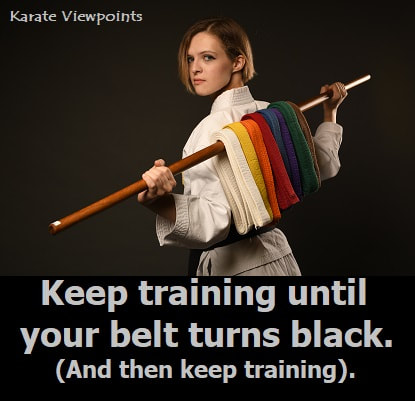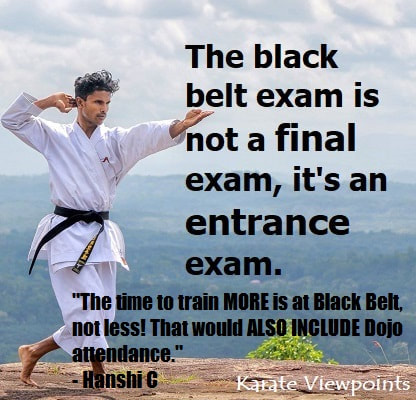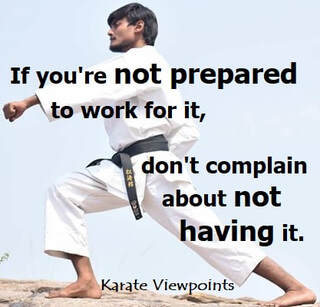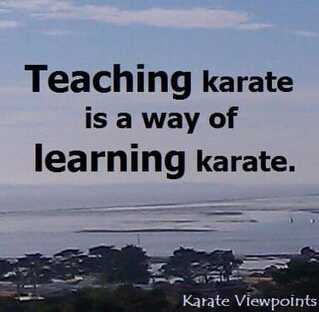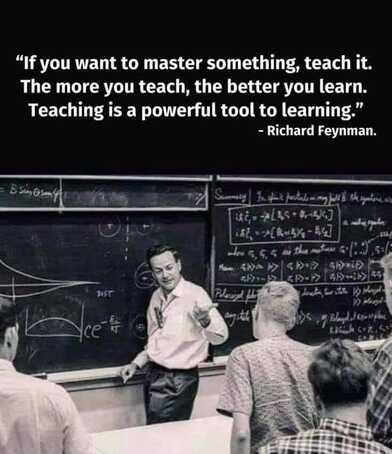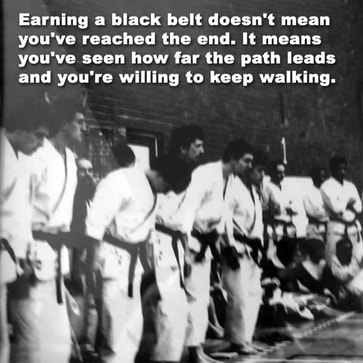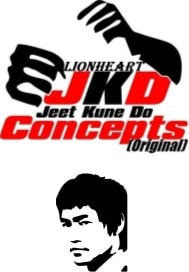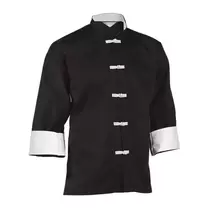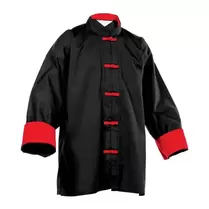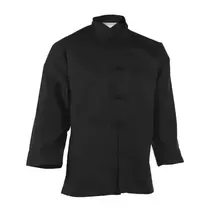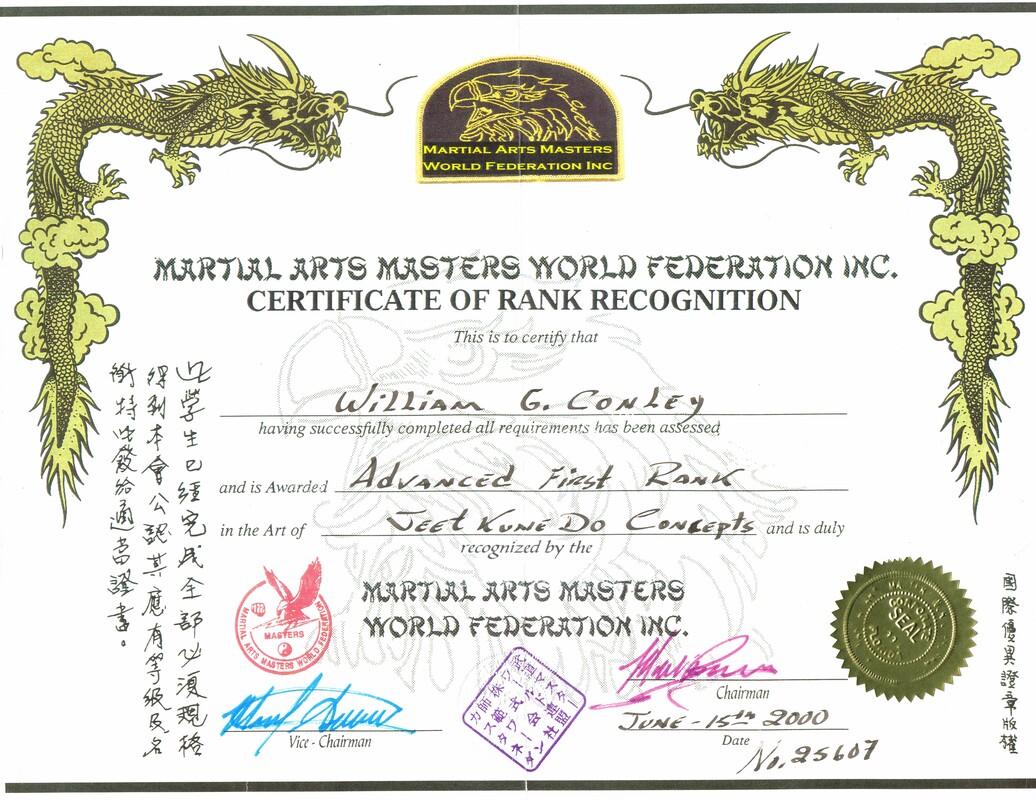
ATTENDANCE is paramount. Martial arts are a perishable skill, meaning it requires regular, consistent practice and class attendance. If a potential student is not ready to do that, then the martial arts are probably not for that potential student. Bottom line: If you are going to only sparsely attend classes throughout or miss classes part of a year> you are NOT practicing martial arts< you are just visiting. We have seating around or near the Dojo/Kwoon floor for that...
- Hanshi C
Belt and Ranking Systems
The average training for each below is based on a two classes per week schedule. St Andrews (SA) & Blacks Harbour (BH) Dojos that only operate one class per week the time-ins are in (brackets). And for Karate Kids' classes, the timeline could still be extended further, three to six months accordingly.
- Hanshi/Sifu C
- Hanshi/Sifu C
Karate Kids, Ages 7 - 15yrs old
Students in this group upon graduating up into the Adult program, in doing so, will drop down one belt level, i.e. a jr green moving into the Adult Program will transition to a solid orange (adult) belt. (The only exception to this protocol is jr black belt*.) When a student moves up into an older level, the belt transition is free of charge. It is in kind of a way, the Dojo honoring their graduation up to an older group by giving them the appropriate belt for that level of entrance.
*In the Karate By The Sea system of ranking, the minimum age for someone to be promoted to certified first degree black belt (Shodan) is 15/16 years old. In the event the student is under the age of 16 years, that student would be promoted to 1st Dan Junior Grade (J.G.), a black belt with a red centre stripe, after passing a appropriate test. It should be noted, that the test for 1st Dan J.G. does not include the two essays, conducting a Dojo class(s), and the physical test is of a lesser level and requirement. Upon reaching the age of 16 years (special dispensation can be to the age of 15), student at the discretion of the Chief Instructor would be tested for full (Adult) black belt, first degree/Shodan, KBTS certified, by completing the full process of two essays and the physical test. Further, it is quite possible for a young student to reach 2nd Degree Junior Black Belt. In that case upon reaching 16yrs, they would as in previous example, test for full (Adult) black belt, first degree/Shodan, KBTS certified. It is very unlikely that there would ever be a 3rd Dan JG Black Belt.
Also, between each colour belt, stripes are earned in the Junior Kenpo JKD program. The stripes signify required techniques and/or form(s) at each belt level. (A stripe can be also awarded to a student in recognition of outstanding performance, or overcoming adversity in their training.) A maximum of three (3) stripes per belt level is structured in the rank system. One stripe represents the required Kumite, the second represents the Kenpo/White Crane Techniques/Exercises or Forms, and the third represents the required JKD techniques at that belt level,. The colour of the stripe(s) corresponds with the next belt colour. There is no cost or test fee for the striping. Students, in the juniors classes, that have achieved their three (3) necessary rank stripes, will on the next available test night challenge for their next belt rank.
Adult Shorin Kenpo Karate, 13yrs and up
Sempai Level
Addressed as, Sempai
Addressed as, Sempai
Q: How long does it take an average person to get a Black Belt?
A: An average person should not get a Black Belt...
A: An average person should not get a Black Belt...
"The time to train MORE is at Black Belt, not less! That would ALSO INCLUDE Dojo attendance."
- Hanshi C
- Hanshi C
The Karate By The Sea black belt system is fashioned: junior black belts are black with a red center. Adult black belts can either be a plain black belt with a red stripe denoting each Dan/Degree level (Which is also used in the American/& other Kenpo systems), or an embroidered black belt with the person's name on the label end and the style on the other belt end. There can also be Dan striping (especially at 2nd Dan and up) on an embroidered belt, above the embroidered name. This style of Dan striping above the name is specific to our system.
The Sensei, "one who has come before..." The Teacher to their students.
Sensei Level (1st thru 4th Degree Black Belt)
Addresssed as, Sensei
Addresssed as, Sensei
You will see listed with some of the Black Belt ranks requirements and responsibilities specific to that in either acquiring and/or maintaining said rank appropriately.

Group Instructor Level I/Jun Shidoin Arm Patch. Jun Shidoin/Level I, Instructor Certification. At least one year after acquiring 1st Dan, a written examination and a practical examination (control and operation of a Dojo) are conducted. Upon successfully passing each, a Jun Shidoin certification is earned. They carry the title of, Group Instructor. An arm patch to denote the rank/certification is worn below on the left upper arm.

Group Instructor Level II/Shidoin Arm Patch. Shidoin/Level I, Instructor Certification. At least one year after acquiring 2nd Dan, a written examination and a practical examination (control and operation of a Dojo) are conducted. Upon successfully passing each, a Shidoin certification is earned. They carry the title of, Group Instructor. An arm patch to denote the rank/certification is worn below on the left upper arm.

4th Dan (Yondan) Average minimum of three to five years of training after becoming a 3rd Dan, before testing for 4th Dan. There are some cases where a person at 4th Dan can be bestowed the title and position of Renshi (-sho). This would be due to special dispensation, such as extended/overdue time as a 3rd Dan, or having great value and done much work for their style/organization. It should be noted, that both Shihans Conley and Adams at 4th Dan, were also Renshi, and in these cases, Shihans Conley and Adams did not wear the Red & Black paneled Renshi Belt. Though it would be acceptable to do so.
The Title system works different, most notably between Okinawan and Japanese systems. As an example: Hanshi in most cases, Dai Nippon Butokukai / Zen Nippon Karatedo Renmei, starts at 8th Dan (Hanshisei Fusei Kise in 2010 coincided with the mainstream (modern) Japanese martial arts practice (and the fore mentioned international organizations) in according the Hanshi title was added to 8th Dan level. In turn the distinguishing title of the Grand Master adds the suffix “Sei”, to become “Hanshi-Sei”, loosely translating as “highest master”). In both Japanese and Okinawan governing bodies (Dai Nippon Butokukai / Zen Nippon Karatedo Renmei), Renshi can start at 4th or 5th Dan (we/Karate By The Sea Dojos start at 5th Dan) and Kyoshi can start at 6th or 7th Dan (7th Dan for our organization). Further, you will also see below, with regard to the Shihan Dai Levels, to the right representative belt column: Kenpo rank belts (Panel/Stripe System). This belt system was first introduced by the Late Senior Grand Master Ed Parker for his American Kenpo system. However now, this belt rank representation is used in many other Kenpo systems, including with ours. And further, regarding American Kenpo, the Title System is also referenced.
Shihan Dai Level Ranks and Titles using the (modern) Dai Nippon Butokukai & Zen Nippon Karatedo Renmei as base references:
Shihan Dai Level (5th thru 10th Dan)
Shihan/Senior Group Head Instructor Level. They carry the title of, Senior Group Instructor. An arm patch to denote the rank/certification is worn below on the left upper arm.
Shihan Dai Level Ranks and Titles using the (modern) Dai Nippon Butokukai & Zen Nippon Karatedo Renmei as base references:
Shihan Dai Level (5th thru 10th Dan)
Shihan/Senior Group Head Instructor Level. They carry the title of, Senior Group Instructor. An arm patch to denote the rank/certification is worn below on the left upper arm.
Shihan Dai/Level 5th thru 7th Degree Black Belt
Renshi Dai/Level
5th & 6th Dan Black Belts are addressed as Shihan
5th & 6th Dan Black Belts are addressed as Shihan
*5th Dan is what I call, "a transitional rank." To use a military analogy, 5th Dan is the transitional rank between the Line Officers, 1st Dan thru 4th Dan, and the Flag Officers, 6th Dan thru 10th Dan.
- Hanshi C
- Hanshi C
Kyoshi Dai/Level
7th Dan Black Belt and is addressed as, Shihan
7th Dan Black Belt and is addressed as, Shihan
Hanshi Dai/Level 8th thru 9th Degree Black Belts
Addressed as, Hanshi
Addressed as, Hanshi
Hanshisei Dai/Level 10th Degree Black Belt
Addressed as, Hanshisei
Addressed as, Hanshisei
*Throughout the Shihan Levels, the time of training between each rank is, "Recommended," meaning that there can be intangibles when promotions are given at the Shihan Levels. Just as there can be at any Black Belt level, if deserving, or for other special dispensation like value to the organization, or if no fault of the candidate, that candidate held a rank for a very long time, then shorter time-in requirements can produce a promotion, in either of the mentioned cases. Additionally, it is always at the discretion, and final decision, of the appropriately ranked test administrator. FURTHER: Applicants, that are Dojo Heads or members of the Association Executive, for the Shihan Levels, only need to meet one of the two requirements (minimum time in/experience, or minimum age), to qualify.
The Title/Level System:
Deshi/Kohai (Student/Junior)
Sempai (Senior)
Sensei (Come Before {One who has})
Junshidoin (Instructor Level I)
Shidoin (Instructor Level II)
Renshi (Polished Expert)
Kyoshi (Teacher)
Hanshi (Master Teacher)
Kaicho (Association/Organization Chief)
Kancho (Style chief> literally means chief/head of the house)
Soke (Founder)
Hanshisei (Grand Master or Highest Master)
Deshi/Kohai (Student/Junior)
Sempai (Senior)
Sensei (Come Before {One who has})
Junshidoin (Instructor Level I)
Shidoin (Instructor Level II)
Renshi (Polished Expert)
Kyoshi (Teacher)
Hanshi (Master Teacher)
Kaicho (Association/Organization Chief)
Kancho (Style chief> literally means chief/head of the house)
Soke (Founder)
Hanshisei (Grand Master or Highest Master)
All of the above belt rank systems are specific to Kenpo Karate. There are no belt/sash systems (almost exclusively) in Jeet Kune Do. There are in our system, upon the decision and evaluation of the Chief Instructor, a certification structure in a three-tier level of ranks: Foundational, Intermediate, and Advanced. Foundational Rank is an assistant instructor rank. Intermediate and Advanced are instructor & senior instructor ranks respectively. These JKD ranks are available to Black Belts ONLY in Red Dragon Kenpo (Shorin Kenpo base). Those with a Foundational/assist. instructor rank can wear in replacement of their gi top a black Chinese "Frog Button" jacket where the buttons and cuffs are white. For Intermediate/instructor rank, the buttons and cuff are red, and for Advanced/ senior instructor rank the buttons and cuffs are black (all black jacket). Eligible Kenpo rank of 1st and/or 2nd Dan can be evaluated/promoted to Foundational Rank. Eligible Kenpo rank of 3rd and/or 4th Dan can be evaluated/promoted to Intermediate Rank. The minimum Kenpo rank for being eligible to be evaluated/promoted to Advanced Rank is 5th Dan or higher. These timelines run pretty much instep with time-in training and promotion in both Kenpo/Karate and Jeet Kune Do, generally. And in each case (Foundational / Intermediate / Advanced) the eligible timelines can fluctuate, somewhat, with respect to each candidate and their abilities, skill, and interpretation. Advancement now in both our Kenpo and JKD will run parallel in the Black Belt levels, in the same way the Jun Shidoin and Shidoin Level I & II certifications/ranks are interfaced into the Kenpo Dan rankings. Our primary systems we present are now Kenpo and JKD. Progression in each will run parallel together. One cannot just decide at 1st or 2nd Dan to go for Intermediate JKD. They must be either 3rd or 4th to do so as an example. Further, the black belt can be worn additionally. By wearing their belt, they are representing both their Kenpo rank and their JKD rank appropriately. As our system(s) we teach is no longer just Okinawan influenced, but also Chinese influenced.
*This based primarily on where the ranks were at the time of Sijo Lee's death, in which Dan Inosanto held the highest certification of Advanced Third Rank. (When I was doing JKD first in the 80s the First Rank and Second and Third had Advanced in front of it, at least with the group I was with, because I think at that time there wasn't going to be anything after (Third was the highest which Inosanto held), but obviously that changed later. You have to understand one of the biggest criticisms to JKD was that it was never upon Lee's death, well structured, or there was really no road map. And that's because Lee died so young at age 32. I am sure Lee thought he wasn’t going to die that young and had a lot more time I believe he thought and would have thought that he had the time to structure his system. He was going to do it but when he left to go to Hong Kong for his movie career to take off, he instructed his schools in Oakland and Los Angeles to be closed at that time. And at that time the highest rank that was given out was to Dan Inosanto which was (Advanced) Third Rank and back in that time especially the few years after his death, people were calling these ranks Advanced: Advanced First Rank, Advanced Second Rank, Advanced Third Rank, as it applied to Inosanto who was the last one to reach the highest point at that time, Advanced Third Rank. In Lee's system when he was getting it going, he had eight ranks and level 8 or Advanced Eighth Rank was a Sijo (Founder) level which was reserved for Lee. But remember upon Lee's death there was no fourth or higher rank holder anywhere. And when I was doing it in the '80s there was talk then that it would not go beyond Advanced Third Rank (Because Insanto held the highest: Third) and that there would be basic and intermediate ranks on the front end of the rank system, which is where I'm trying to be at today.
So today there are people in organizations and groups, JKD groups, that hold their Advanced Sixth or Seventh Rank or whatever and they're testing people and promoting them to Advanced Second, Third>or higher Ranks. How is that so? In theory Dan Inosanto would be the only one who could parallel promote someone to Advanced Third Rank only him and when Ted Wong was alive he could have parallelled rank someone to Second Rank and those with First Ranks could parallel some to First. So how is it today that there are people being promoted to Third Rank and Fourth and Fifth if Inosanto was the last to be ranked by Sijo Bruce Lee a (Advanced) Third Rank? It's because whoever is doing it, promoted themselves, or found some way to build a path or say that oh no I've been doing this for so long I can be this high rank now. Well I’m not following that path and it's not important as to how many certificates you have in JKD it's only important how well you do it. So I haven't raised my rank or made myself into a grand master or whatever or Advanced Rank Sixth or Seventh or whatever to equal what I am in Kenpo Karate as an example. It's not necessary, it's wrong and I'm not going to do it. I will simply as my students progress, and the possibility is there for a candidate, I will only parallel rank them as high as Advanced (First), and I will on the front end use a Foundational and Intermediate (one of each) certifications.
Yes, my ranking in JKD is from an independent organization as are many of my ranks in my other systems that I'm ranked. And I'm not going to argue with those that would say whether it's legitimate or not. As the main systems are so political and there is so much chase for the money and we could go into the depths of the darkness that some sides of the martial arts have, not going there. And many of my rankings, they are from independent organizations and groups, because I did not want to go through the politics and quite frankly the brainwashing that you see in the main systems and their main organizations. I played that game for a while and it was a mess. In the old days of martial arts you were never asked what your rank was in most cases the question of your rank wasn't even brought up, it was how many years have you trained, and who were your teachers. Well I have that cannot be disputed 45 years plus of experience still going hopefully God willing many more and I've had some great teachers who are highly respected. And in my mind that is the most important. When you delve into rank in the martial arts it is a deep quagmire of quicksand and no one wins. I simply want to train and to teach my students that's it.
- B Conley
So today there are people in organizations and groups, JKD groups, that hold their Advanced Sixth or Seventh Rank or whatever and they're testing people and promoting them to Advanced Second, Third>or higher Ranks. How is that so? In theory Dan Inosanto would be the only one who could parallel promote someone to Advanced Third Rank only him and when Ted Wong was alive he could have parallelled rank someone to Second Rank and those with First Ranks could parallel some to First. So how is it today that there are people being promoted to Third Rank and Fourth and Fifth if Inosanto was the last to be ranked by Sijo Bruce Lee a (Advanced) Third Rank? It's because whoever is doing it, promoted themselves, or found some way to build a path or say that oh no I've been doing this for so long I can be this high rank now. Well I’m not following that path and it's not important as to how many certificates you have in JKD it's only important how well you do it. So I haven't raised my rank or made myself into a grand master or whatever or Advanced Rank Sixth or Seventh or whatever to equal what I am in Kenpo Karate as an example. It's not necessary, it's wrong and I'm not going to do it. I will simply as my students progress, and the possibility is there for a candidate, I will only parallel rank them as high as Advanced (First), and I will on the front end use a Foundational and Intermediate (one of each) certifications.
Yes, my ranking in JKD is from an independent organization as are many of my ranks in my other systems that I'm ranked. And I'm not going to argue with those that would say whether it's legitimate or not. As the main systems are so political and there is so much chase for the money and we could go into the depths of the darkness that some sides of the martial arts have, not going there. And many of my rankings, they are from independent organizations and groups, because I did not want to go through the politics and quite frankly the brainwashing that you see in the main systems and their main organizations. I played that game for a while and it was a mess. In the old days of martial arts you were never asked what your rank was in most cases the question of your rank wasn't even brought up, it was how many years have you trained, and who were your teachers. Well I have that cannot be disputed 45 years plus of experience still going hopefully God willing many more and I've had some great teachers who are highly respected. And in my mind that is the most important. When you delve into rank in the martial arts it is a deep quagmire of quicksand and no one wins. I simply want to train and to teach my students that's it.
- B Conley
Karate By The Sea Kenpo & LIONHEART Kenpo Jeet Kune Do are divisions of Conley's Martial Arts















